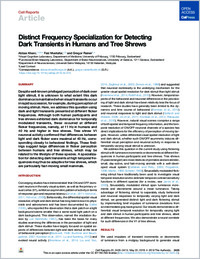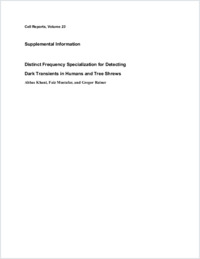Distinct frequency specialization for detecting dark transients in humans and tree shrews
- Khani, Abbas Visual Cognition Laboratory, Department of Medicine, University of Fribourg, Switzerland - Functional Brain Mapping Laboratory, Department of Basic Neurosciences, University of Geneva, Switzerland -
- Mustafar, Faiz Visual Cognition Laboratory, Department of Medicine, University of Fribourg, Switzerland - Department of Neurosciences, Universiti Sains Malaysia, Kelantan, Malaysia
- Rainer, Gregor Visual Cognition Laboratory, Department of Medicine, University of Fribourg, Switzerland
-
22.05.2018
Published in:
- Cell Reports. - 2018, vol. 23, no. 8, p. 2405–2415
English
Despite well-known privileged perception of dark over light stimuli, it is unknown to what extent this dark dominance is maintained when visual transients occur in rapid succession, for example, during perception of moving stimuli. Here, we address this question using dark and light transients presented at different flicker frequencies. Although both human participants and tree shrews exhibited dark dominance for temporally modulated transients, these occurred at different flicker frequencies, namely, at 11 Hz in humans and 40 Hz and higher in tree shrews. Tree shrew V1 neuronal activity confirmed that differences between light and dark flicker were maximal at 40 Hz, corresponding closely to behavioral findings. These findings suggest large differences in flicker perception between humans and tree shrews, which may be related to the lifestyle of these species. A specialization for detecting dark transients at high temporal frequencies may thus be adaptive for tree shrews, which are particularly fast-moving small mammals.
- Faculty
- Faculté des sciences et de médecine
- Department
- Département de Médecine
- Language
-
- English
- Classification
- Biological sciences
- License
- License undefined
- Identifiers
-
- RERO DOC 322911
- DOI 10.1016/j.celrep.2018.04.076
- Persistent URL
- https://folia.unifr.ch/unifr/documents/307114
Other files
Statistics
Document views: 55
File downloads:
- rai_dfs.pdf: 136
- rai_dfs_sm1.pdf: 88

